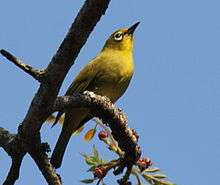African yellow white-eye
| African yellow white-eye | |
|---|---|
.jpg) | |
| Kakamega Forest, Kenya | |
| Scientific classification | |
| Kingdom: | Animalia |
| Phylum: | Chordata |
| Class: | Aves |
| Order: | Passeriformes |
| Family: | Zosteropidae |
| Genus: | Zosterops |
| Species: | Z. senegalensis |
| Binomial name | |
| Zosterops senegalensis | |
The African yellow white-eye (Zosterops senegalensis) is a species of bird in the family Zosteropidae.
Description
A small yellow bird with a prominent white eye ring surrounding a dark eye. The underparts and head are yellow, with a black loral stripe, black bill, the flight and tail feathers are brown edged with yellowish olive. Some subspecies are greener, especially those occurring in forest. Juveniles are darker.[3] This bird measures 11·5 cm in length and the weight varies from 6.8 to 14.1g.[4]

Distribution
The African yellow white-eye is widely distributed in sub-Saharan Africa from Senegal, Gambia and Mauretania in the west east to Ethiopia and Eritrea then south to northern Namibia and KwaZulu Natal in South Africa.[4][5]
Habitat
The African yellow white-eye is a bird which prefers well-wooded habitats, especially thorn scrub, savanna woodland, lowland and montane forest, also occupying swamps with interspersed trees, Eucalyptus plantations, suburban parks and gardens.[3][5]
Habits
The African yellow white-eye has been recorded as a host of the brood parasite green-backed honeybird.[5]
The African yellow white-eye has a diet that mainly consists of insects; caterpillars, aphids and termite alates have all been recorded, supplemented with some fruit including those of figs and the cabbage tree Cussonia spp. It forages among the canopy of trees, gleaning prey from foliage and bark. It is frequently recorded as a member of mixed-species foraging flocks.[5] Also takes nectar from flowers.[3]
The nest is a small cup made out of dried grass and small twigs, placed among the foliage in a small tree about 3.5m above the ground and secured with spider web. The clutch of 2-4 eggs is laid from August–January, with most being laid in September–October. Incubation takes about 11–12 days and both sexes share this duty as well as the feeding of the nestling young which fledge after around two weeks If disturbed in the nest the young will often panic and jump out of the nest.[5]
Taxonomy
The African yellow white-eye may form a superspecies with Abyssinian white-eye, Montane white-eye and Orange River white-eye. The taxa from Central Africa, by most authorities considered subspecies of the African yellow white-eye, is now sometimes considered a separate species, the forest white-eye, (Zosterops stenocricotus).[4]
There are currently fourteen recognised subspecies and they are listed below with their distributions:[2][4]
- Zosterops senegalensis senegalensis Bonaparte, 1850: Southern Mauritania, Senegal and Guinea east to southern Chad, Central African Republic (except south-west), South Sudan, north western Ethiopia and northern Eritrea.
- Zosterops senegalensis demeryi Büttikofer, 1890: Sierra Leone, Liberia and Ivory Coast.
- Zosterops senegalensis stenocricotus Reichenow, 1892 – South-eastern Nigeria, the highlands of Cameroon and south-western Central African Republic south to northern Gabon, also on Bioko (formerly Fernando Póo).
- Zosterops senegalensis gerhardi van den Elzen & König, 1983 – southern South Sudan and north eastern Uganda.
- Zosterops senegalensis toroensis Reichenow, 1904 – north-eastern Democratic Republic of Congo and western Uganda.
- Zosterops senegalensis reichenowi A. J. C. Dubois, 1911 – Eastern Democratic Republic of Congo in the highland forests west of Lake Kivu and north west of Lake Tanganyika.
- Zosterops senegalensis stuhlmanni Reichenow, 1892 – south central Uganda south to north-western Tanzania.
- Zosterops senegalensis jacksoni Neumann, 1899 – highlands of Kenya and northern Tanzania, Loliondo.
- Zosterops senegalensis stierlingi Reichenow, 1899 – highlands of eastern Zambia, southern and eastern Tanzania, Malawi and north and north-western Mozambique.
- Zosterops senegalensis kasaicus Chapin, 1932 – Central Democratic Republic of Congo south to north-eastern Angola.
- Zosterops senegalensis heinrichi Meise, 1958 – north-western Angola.
- Zosterops senegalensis quanzae Meyer de Schauensee, 1932 – Central Angola.
- Zosterops senegalensis anderssoni Shelley, 1892 – savannas of south-eastern Democratic Republic of Congo , south western Tanzania, western Malawi and western Mozambique south to southern and eastern Angola, northern Namibia, northern and northeastern Botswana, western and northern Zimbabwe and northern South Africa, in the eastern Limpopo lowveld.
- Zosterops senegalensis tongensis Roberts, 1931 – lowlands of south-eastern Zimbabwe, southern Mozambique and north-eastern KwaZulu Natal, South Africa.
References
- ↑ BirdLife International (2012). "Zosterops senegalensis". IUCN Red List of Threatened Species. Version 2013.2. International Union for Conservation of Nature. Retrieved 26 November 2013.
- 1 2 "Zosterops senegalensis Bonaparte, 1850". Integrated Taxonomic Information System (ITIS) (https://www.itis.gov). Retrieved 2016-11-09.
- 1 2 3 Borrow, Nik; Demey, Ron (2001). Birds of Western Africa. A & C Black. p. 699. ISBN 0-7136-3959-8.
- 1 2 3 4 "African Yellow White-eye (Zosterops senegalensis)". HBW Alive. Lynx Edicions. Retrieved 2016-11-09.
- 1 2 3 4 5 "Zosterops senegalensis (African yellow white-eye)". Biodiversity Explorer. Iziko Museums of South Africa. Retrieved 2016-11-09.
External links
- Species text - The Atlas of Southern African Birds
